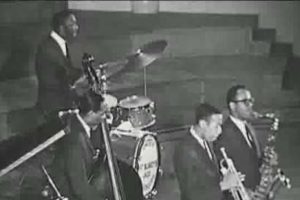Peggy Lee, one of the biggest stars of her generation, lived from May 26, 1920 to January 21, 2002. Born Norma Deloris Engstrom (sometimes Egstrom, according to Wikipedia), Lee grew up in Jamestown, Dakota.
Engstrom/Egstrom first sang professionally on KOVC radio in Valley City, ND and soon had her own show, which was sponsored by a local restaurant and paid her in food. (This was towards the end of The Depression, so that probably was a very good deal.) At 17, Engstrom/Egstrom changed her name to Peggy Lee and moved to Los Angeles. She eventually landed a job at the Doll House, a club in Palm Springs. There, the profile says, Lee developed “her trademark sultry purr.” The idea was to deal with the background noise with subtlety, not volume.

Lee eventually moved to The Buttery Room, which was a nightclub in the Ambassador Hotel East in Chicago. She was noticed by Lady Alice Duckworth, who was Benny Goodman’s fiancée. She brought Goodman the next evening and Lee eventually replaced Helen Forrest in the band.
There are many sites that do a far better job than I can in detailing the careers of famous musicians. The beginnings, generally, are more interesting than the ends – and certainly more upbeat. An interesting note is that Lee, who became an actress as well, was the model for The Muppets’ Miss Piggy.
The song above is “Similau,” which was pointed out to me by my brother, who knew of the song and was surprised and happy to hear it featured in an ad for the Samsung Galaxy Note8. Variety, in an interesting story on the use of the song in the commercial, described the rationale for use of the song by the producers. Definitions.net says that the title can be translated to mean “spirit in the woods,” which is the first line of the song. The entry says that the song also sometimes is called “I Similau,” which would mean “I like it” or “I liked it” in Basque.

The exotic song was written by Arden Clar and Harry Coleman and the copyright controlled, at least at some point, by Paul McCartney. It is unclear from the story whether that still is the case.
Lee certainly has found a place in modern culture. Below is “Why Don’t You Do Right,” with Lee alongside Benny Goodman. That 1943 song, and not “Similau,” is among Lee’s top ten hits, at least according to Zoomer Radio. The other nine: “Is That All There Is?” (1969); “Fever” (1958); “I Don’t Know Enough About You” (1946); “Waiting for the Train to Come In” (1945); “Somebody Else is Taking My Place” (1942); “Lover” (1952); “Riders in the Sky” (1949); “Golden Earrings: (1947) and “Manana” (1948)
Lee missed have a hit in four decades by one year. Here is Peggy Lee’s very comprehensive website. It lays out the life of a very important personality of the twentieth century.


















Recent Comments